August 21st, 2014 §
Last weekend I picked what felt like about 50 pounds of tomatoes. I have only ten plants, but it’s been an unreal tomato season here—the best since I’ve started the farm. I have no doubt that it correlates with our cooler-than-usual summer. When tomatoes are exposed to the high temperatures (day/night temperatures of 95/80°F) that are common during a typical Virginia summer, it significantly reduces the number of pollen grains that each flower produces and releases and decreases the pollen’s viability. No pollen = no fertilization = no tomatoes! But this year, which has been cool enough that I’ve had my air conditioning off more than on, with night time temperatures regularly in the 50s, has kept the tomatoes happy and pumping out fruit.
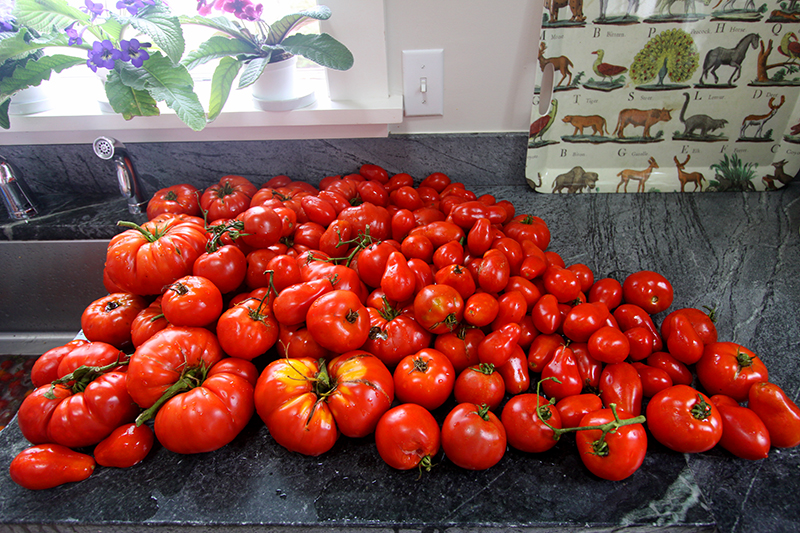
I recruited my mom to help me process these beautiful tomatoes, and we made a good team. She washed and scored each tomato with a knife. Then I dunked them for 30 seconds in boiling water before plunging them into a cooler water bath. I slipped off the skins and chopped/crushed each tomato to pulp before adding it to one of three stockpots I had bubbling on my stove. With fistfuls of basil, a couple of heads of roasted garlic, and a bit of salt, the tomatoes cooked down into a sweet, beautiful, nutritious sauce free of pesticides, preservatives, and all the other frightful things that show up in commercial sauce (e.g., high-fructose corn syrup).
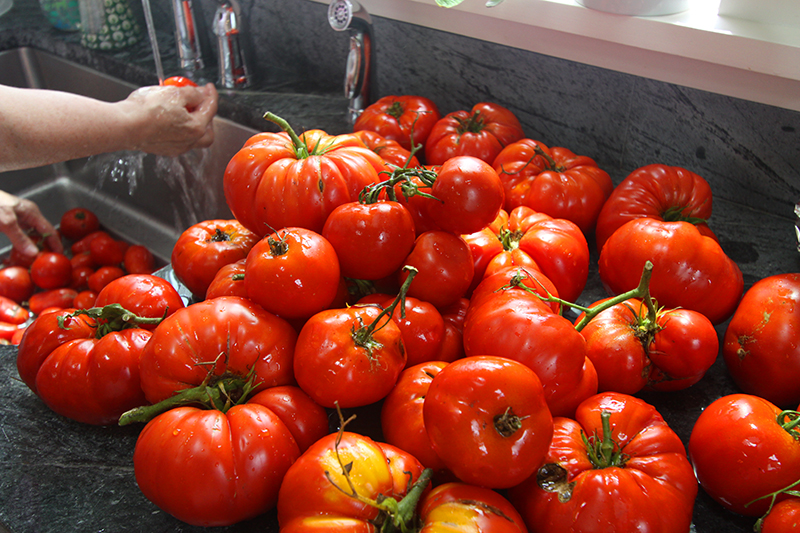
It’s not clean work, and it’s hot standing over boiling water for a couple hours. But I know that last year when it was brutally cold outside and I opened up my freezer to find containers of homegrown, homemade tomato sauce, it made winter just a bit more bearable.
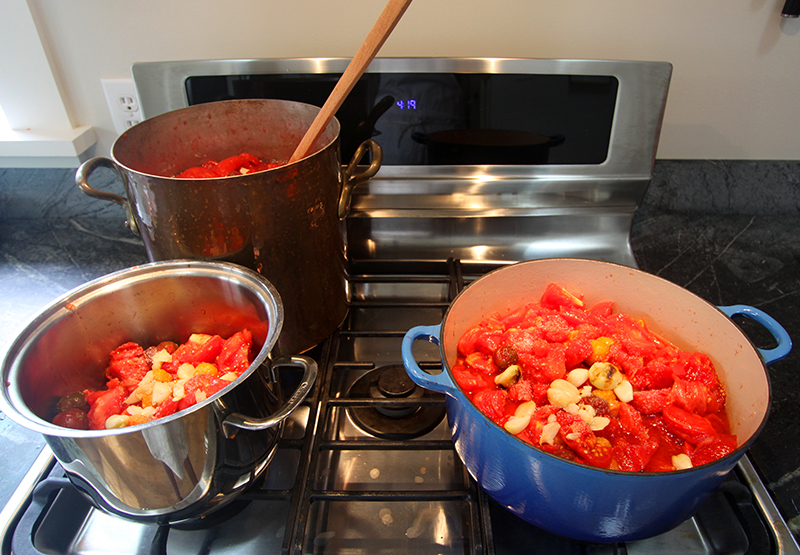
July 20th, 2014 §
After the interminable cold of last winter, I am making a conscious effort to gorge on summer with both beautiful, fresh foods and warm-weather experiences. Already it’s the end of July: I saw my first reddening maple this week and the locust trees are browning out—both surefire reminders that we’re slipping toward darker, colder days.

Last week I spent the afternoon at a nearby lake beach, swimming with a friend and her three small children. It was so much fun but what a workout supporting two nonswimming kids at a time in the water while making sure no one drowned! I brought about ten pounds of cut-up watermelon and we polished it off. Sandy watermelon definitely screams summer.

Then Friday I took a date and his dog hiking in the mountains. Tuck got to swim and run trails all day with the first female dog he’s spent much time with, and I think he’s in love.

Humans and canines enjoyed a big swimming hole in a shady, mossy glen way up on the mountain, and during our picnic I met a new-to-me butterfly, the Zebra Swallowtail, that flitted around us for hours. It was my favorite colors—pale aqua and coral. It felt great to spend two days in a row swimming in natural bodies of water.

Yesterday was cloudy and cool, so I cooked all afternoon in front of the open windows, listening to the bird life outside. I roasted a bunch of cherry tomatoes, which are ripening in overwhelming succession, caramelized onions for about 45 minutes, and blanched the year’s first little “Nickel” green beans. All that plus a handful of chopped basil and some shredded provolone went into a quiche made with my chicken’s own eggs, and it was the best quiche I’ve ever made. And it didn’t even include my usual bacon or sausage!
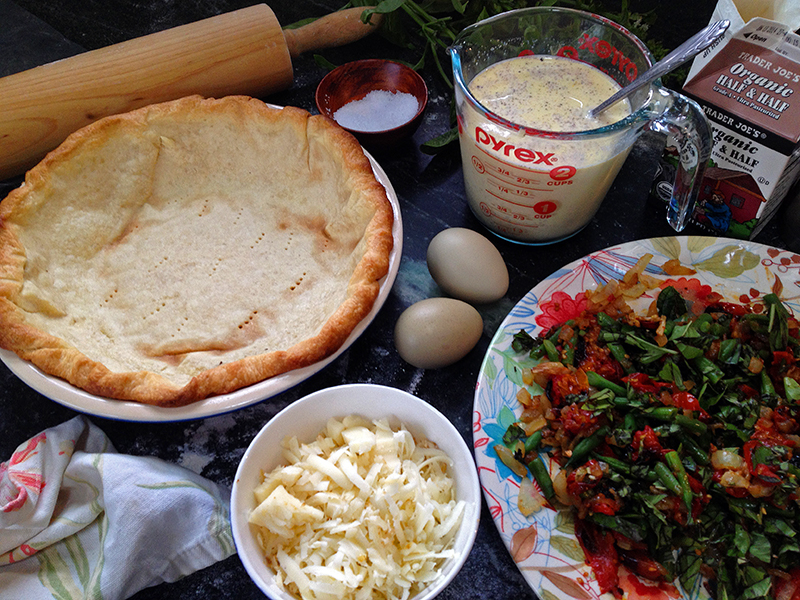
I think, after years of experimenting, I’ve found a good crust recipe. I’ve never been particularly in love with any of my crust recipes, but this one worked perfectly. And it’s so easy I can write it here from memory:
145 grams of flour
1 stick of butter, roughly chopped into 1/8″ pieces (my butter was frozen, and it was fine)
1/2 tsp. kosher salt
3 tbs. ice water
Spin flour and salt in food processor, then add butter and process to coarse crumbs. Dump in all the ice water and then—here’s where it goes against other recipes I’ve used—process regularly for about 30 seconds. It will feel like you are overprocessing, but the crumbs will come together into a perfectly smooth dough right at 30 seconds. Stop as soon as that happens, take out, shape into a disk and chill. Overnight is recommended but I just did it for an hour and it was still okay. Then roll out, dock, and blind bake for 15 min at 450 degrees. Cool, fill and bake again with whatever you want in it. Easy—and a life victory to have finally lit upon a recipe and technique that worked well!
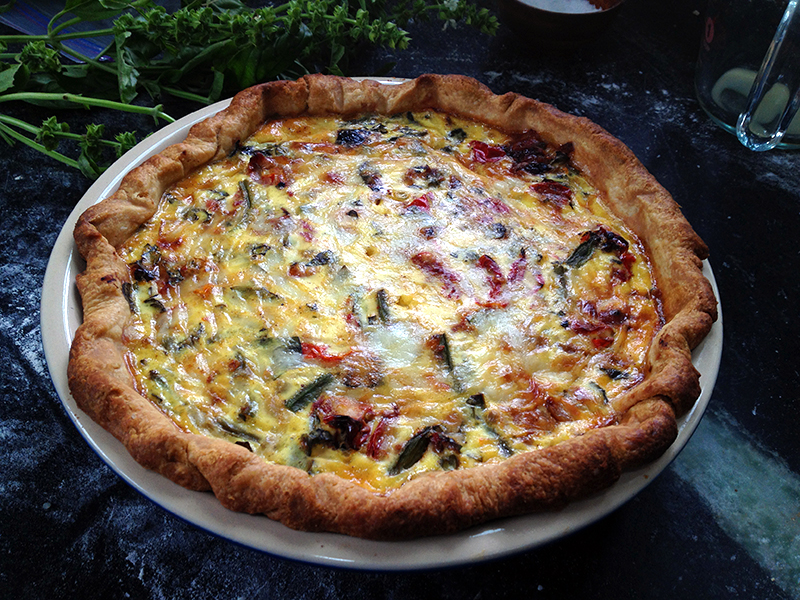
While the quiche was baking I threw together a couple of jars of refrigerator pickles. We have entered the time of year when it’s hard to keep up with the garden’s output, but I love the challenge of having to turn tons of produce into meals.
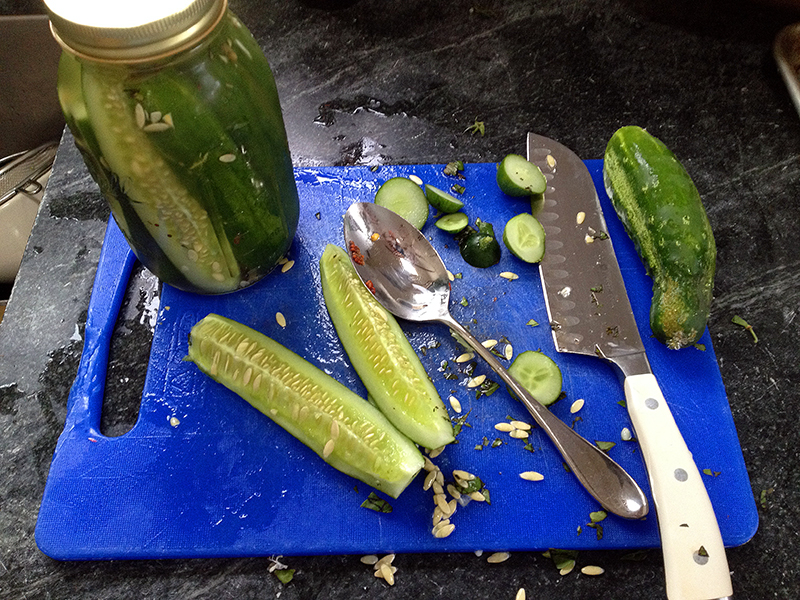
Speaking of which, my garden/kitchen task today is to shred and freeze squash. I think I will also attempt a savory zucchini bread—the weather is so cool that it’s a good weekend to have the oven running!
And then maybe, hopefully, my dog and I will find our way to a river. Because it’s summer, and the season for swimming.
July 17th, 2014 §
I love this time of year when my kitchen counter is an artwork that changes every day.
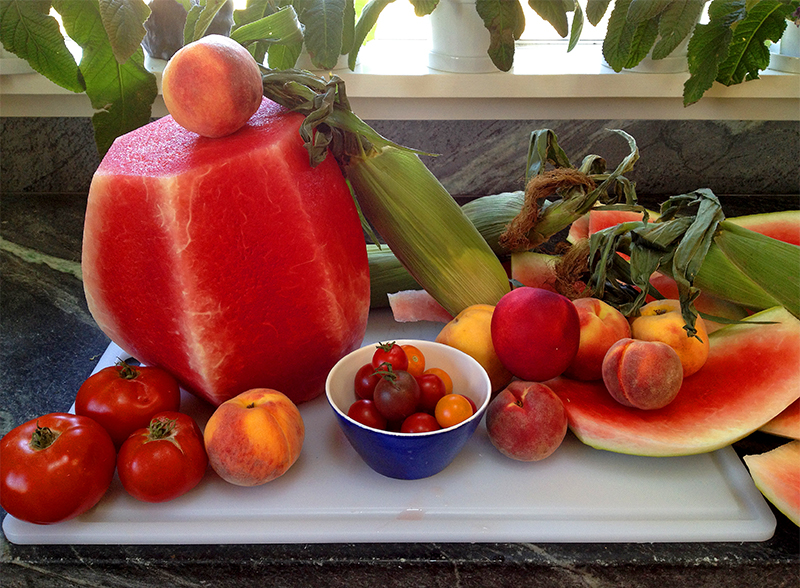
June 26th, 2014 §
This is the first harvest of summer 2014—a few squash and zucchini that managed to outrun the oncoming squash bugs, some hot peppers, basil and other herbs, and five Sun Sugar tomatoes. Tomatoes before the fourth of July—not bad considering our long, cold spring.
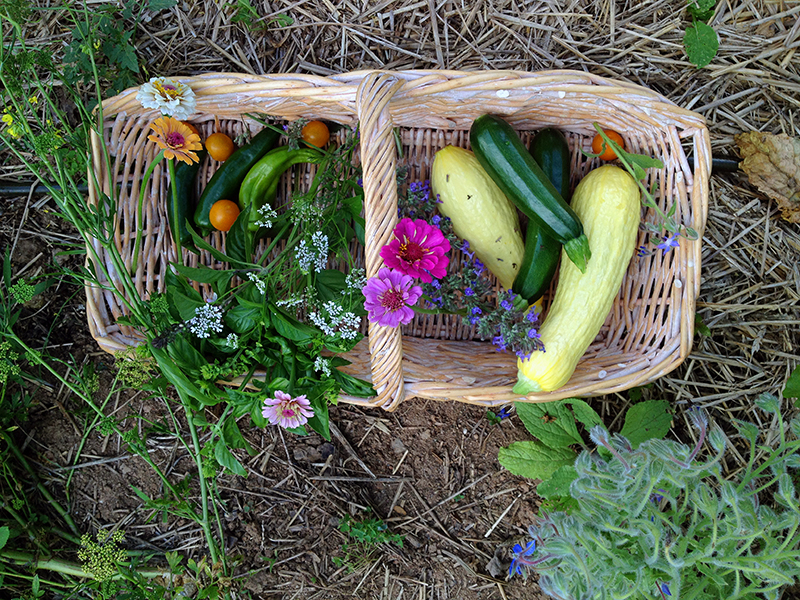
The zinnias are just coming on, and I bet tomorrow I will see the first cosmos bloom. It is great to be back in the cutting flower business. From now until frost there will be homegrown bouquets all around my house. 
Such bounty calls for a celebration with fire. As I didn’t do much for the Solstice this past weekend, I fired up the grill to cook a first harvest/Solstice feast as thunder bounced around the mountains. I just got the grill a few weeks ago, a gift from my mom, and it’s been a steep learning curve to understand this entirely new way of cooking. It’s a good challenge, and one I needed as my culinary selfeducation had grown stagnant. It feels wonderful to push myself, to make mistakes, have “eureka” moments and accidental epiphanies, and at the end of it all, if I’m lucky, dinner.
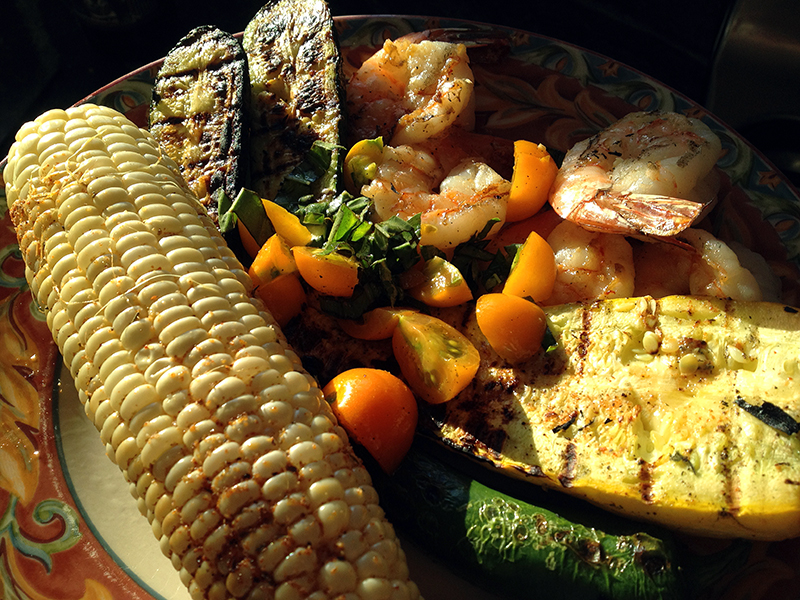
And what a dinner it was. Garlic shrimp, my veg, some corn slathered with butter and seasonings and wrapped back up in its husk to grill. A simple, perfect salsa made with my five pretty gold tomatoes, basil, salt, pepper and olive oil. These squash were on a whole other level from the pallid supermarket varieties I grilled last week. Call me a tree-hugging hippie, but I can taste a difference when I eat something I planted in April as a two-leafed seedling, nurtured and protected, and finally harvested within twenty minutes of consuming. Vegetables taste alive, almost meat-like in their nutrition and vitality. They go straight to my brain.
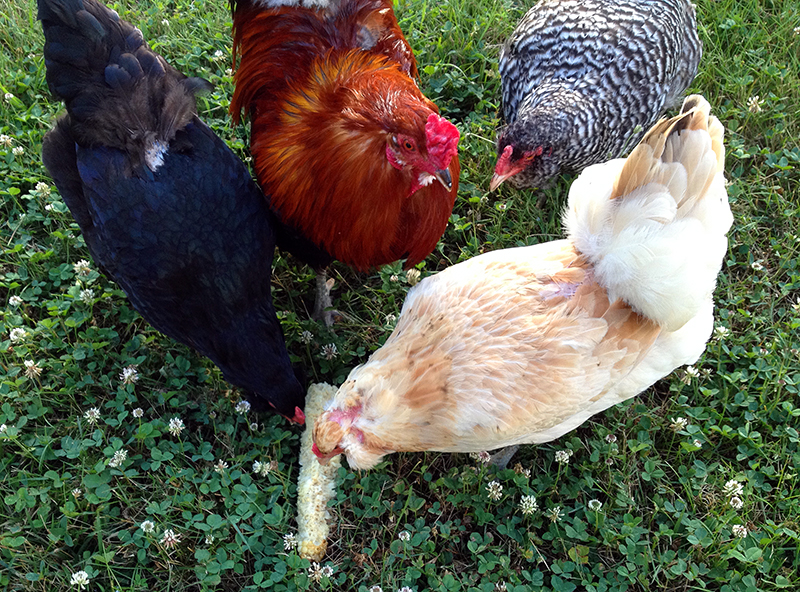
And, nothing is wasted.
May 1st, 2014 §
The overwintered ‘Red Russian’ kale has been a real treat this spring—sweet, tender and delicious. Unfortunately it’s already begun to bolt (go to seed), which means that the kale will gradually get tougher and more bitter as its energy goes into reproduction.
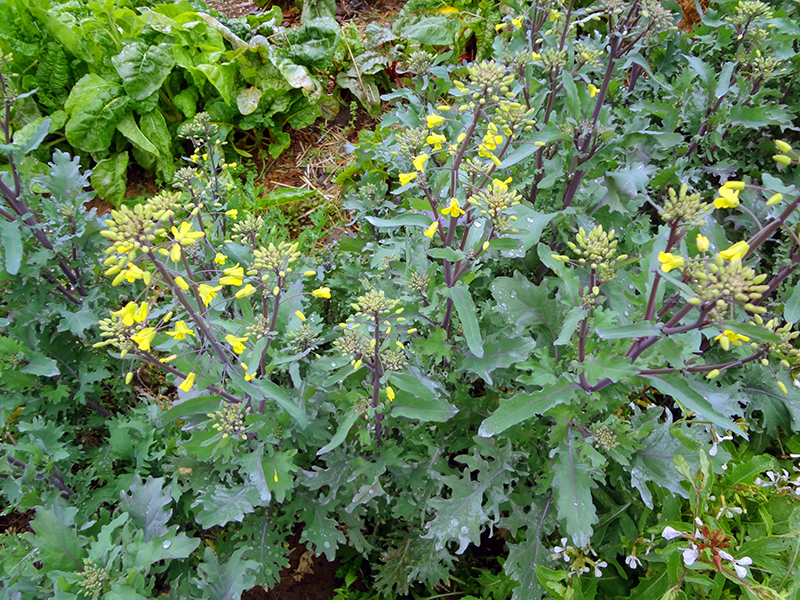
I’ve been harvesting kale almost every day, and the other night I cut off the flower heads to try to slow the bolting process. I nibbled on some of the flower heads and found them delicious. Further down the stem was edible and tasty as well, with a texture like very thin asparagus.
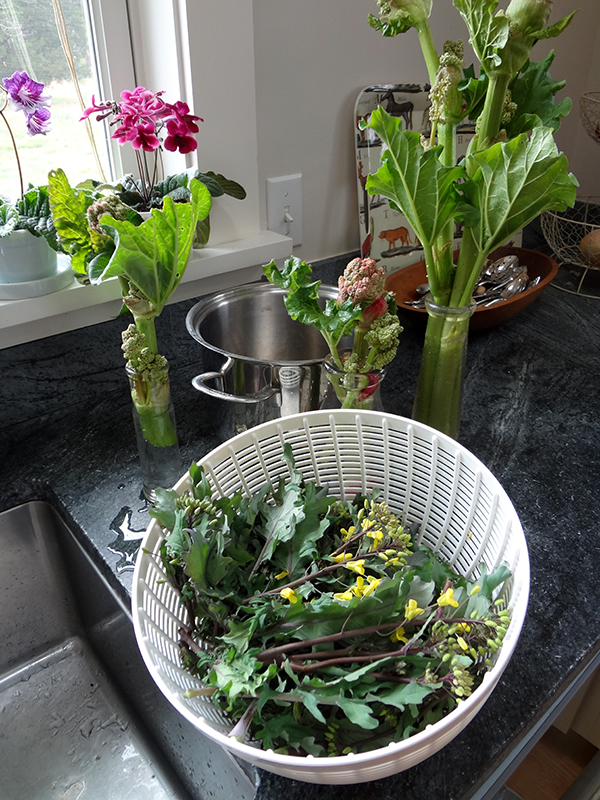
I washed the flowering heads and gave them a rough chop. They went into a saute pan with olive oil, a clove of chopped garlic, and a few golden raisins. A few seconds on high heat cooked them to perfection, just wilted through but still vibrant, healthful green.
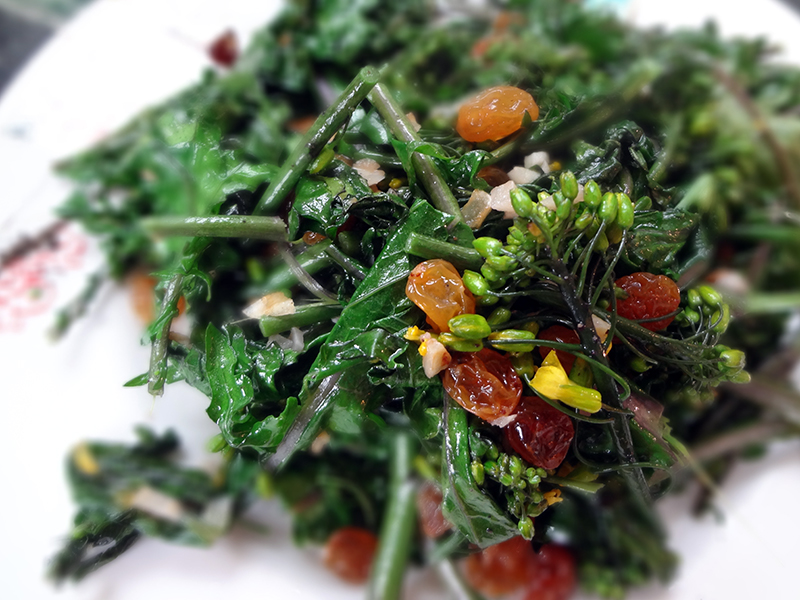
I’m pretty sure that as the season goes on these flowering heads won’t be nearly as delicious, but if you can catch them in these first days of spring you’ll enjoy an unusual treat.
July 28th, 2013 §
Make tomato sauce and buy a chest freezer.

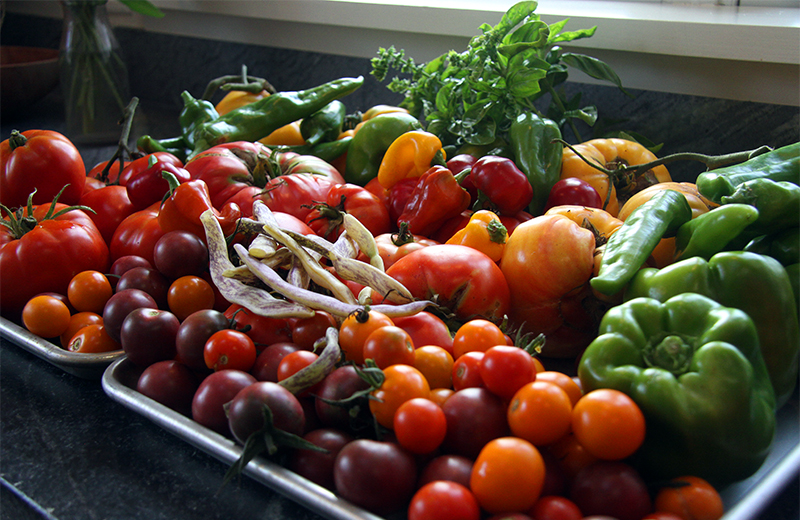
But tonight, for dinner, the first B.L.T. of the season. My favorite sandwich, and one I don’t even bother with unless I make my own, with homegrown ingredients. Tomato juice ran down my arms as my eyes filled with tears of bliss. If this sandwich were my last meal, I would die a happy woman.
July 25th, 2013 §
I picked my first full-size tomatoes last Thursday. Winning the race were heirloom Mr. Stripey, the yellow below, and hybrid New Girl, the large red. Of course, the yellow cherry Sun Sugar has been producing for a couple of weeks already, as has Black Cherry. This is a great year to test Sun Sugar as a replacement for last year’s Sun Gold, which split too much for my liking. Even with rainfall running 200% of normal for July, the Sun Sugars are not yet splitting and I find the taste just as good.
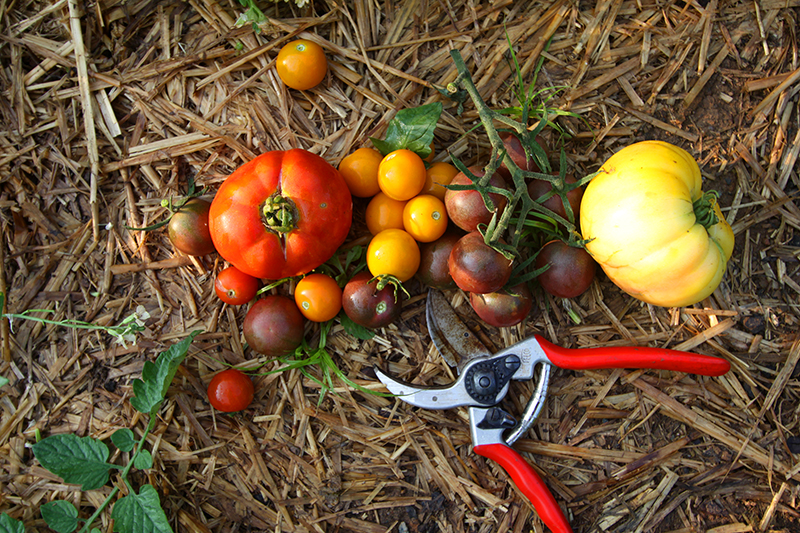
To celebrate these first tomatoes I had a few friends over for pizza and caprese salad made with fresh mozzarella and garden basil. Delicious!
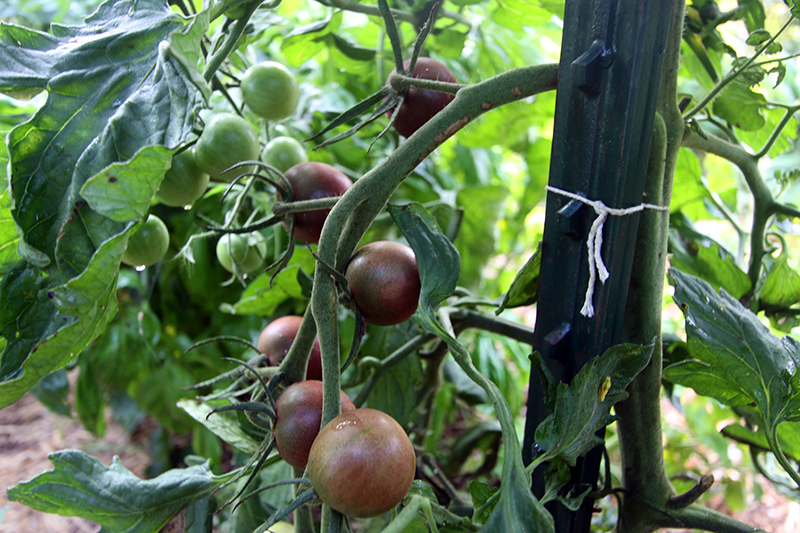
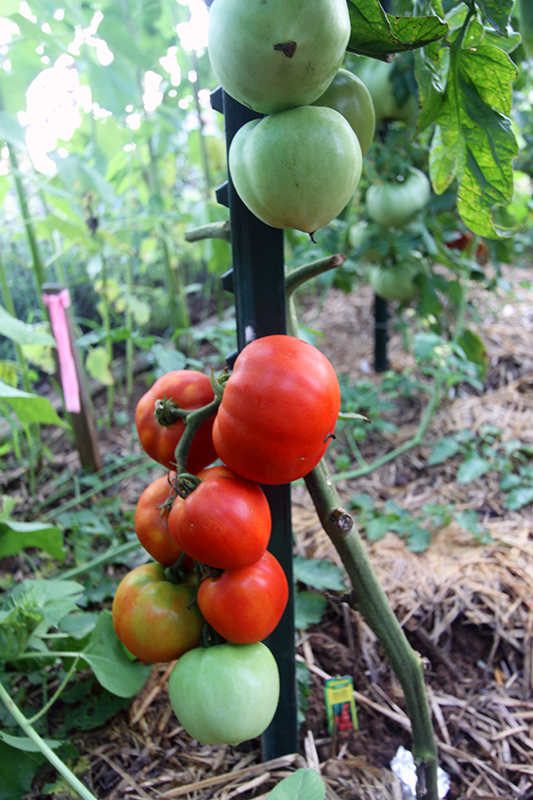
Last week’s heat wave seems to have taken its toll on the the fruiting of some tomatoes. When the temperature and humidity levels get too high, tomatoes will flower but fail to set fruit because their pollen becomes unviable. Some heirlooms are particularly susceptible to this. Here’s a good example, in Mr. Stripey, which developed a massive cluster of fruit near the soil but now has very few developing tomatoes further up the stem and evidence of lots of unpollinated blossoms.
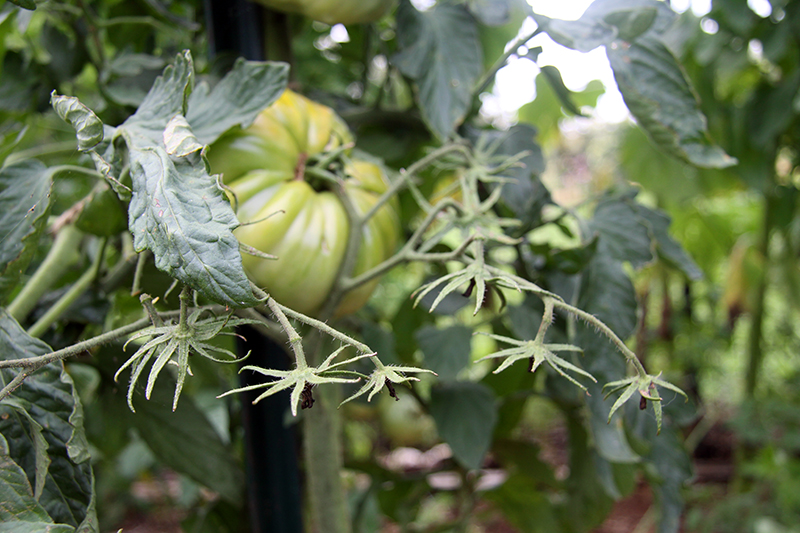
Plants may resume fruiting when temperatures drop, as long as they haven’t first succumbed to disease. I’m happy that signs of blight are still very minimal in my tomatoes, which is a good accomplishment with all the rain, heat and humidity we’ve had. And thus far I have used no chemical controls, just proper nutrition and garden hygiene.
May 30th, 2013 §
Ever since I moved to Bonafide Farm, I’ve wanted to grow hops. But the infrastructure always stopped me. Hops are vines (actually, botanically they are bines) that will grow 20′ or more, and need trellises that I just didn’t have the energy to conceive and build.
But in mid-April I was down in Nelson County, which is now regionally acclaimed for its breweries (Devil’s Backbone, Blue Mountain, etc.) enjoying a post-hike flight at Wild Wolf with some friends. A sign at a shop across the patio advertised hop rhizomes. I couldn’t resist. Turns out I had discovered HomebrewZ!, a delightful little shop stocking all your homebrew essentials.
A very lovely woman sold me her last seven Cascade rhizomes and instructed me to “go across the way” to speak with another woman who would impart all the secrets of hops culture to this neophyte. I got the skinny from this sage and rejoined my friends and our dogs on the patio.
The rhizomes,which are nothing more than 3-4″ twigs, languished in a paper bag until I could do a little research and make a trip to the hardware store for supplies. Then my friend Simon and I spent an evening hauling forest topsoil and compost to the site of an old berry patch by the south side of the garage. Once we had the soil nice and juicy (hops are heavy feeders with an extensive root system), I mounted the ladder, drill in hand.
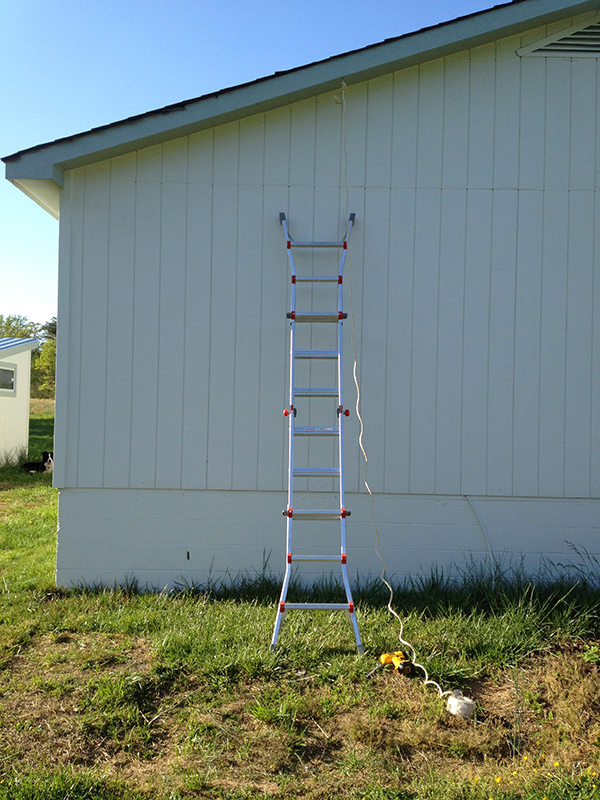
Right up under the eaves I installed two stainless steel eye-bolts. Then I ran 3/8″ sisal rope from them down to dog tie-outs that I’d screwed in to the growing bed. And this was the extent of my trellis system. One of the best things I have learned from living here is that sometimes things work out best when I am just pushed to react to what a situation demands, instead of obsessively planning to the point of inaction.
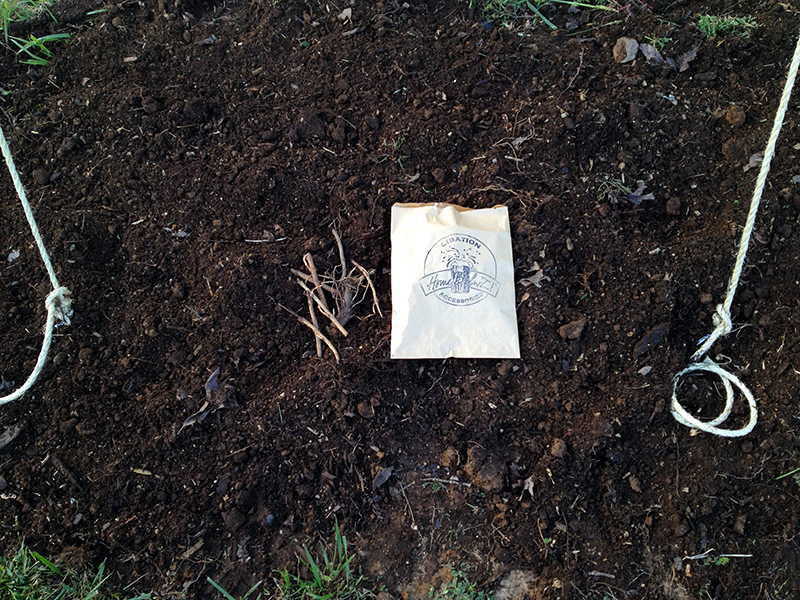
I arranged the rhizomes in the soil around each tie-out, covered them over, and hoped for the best.
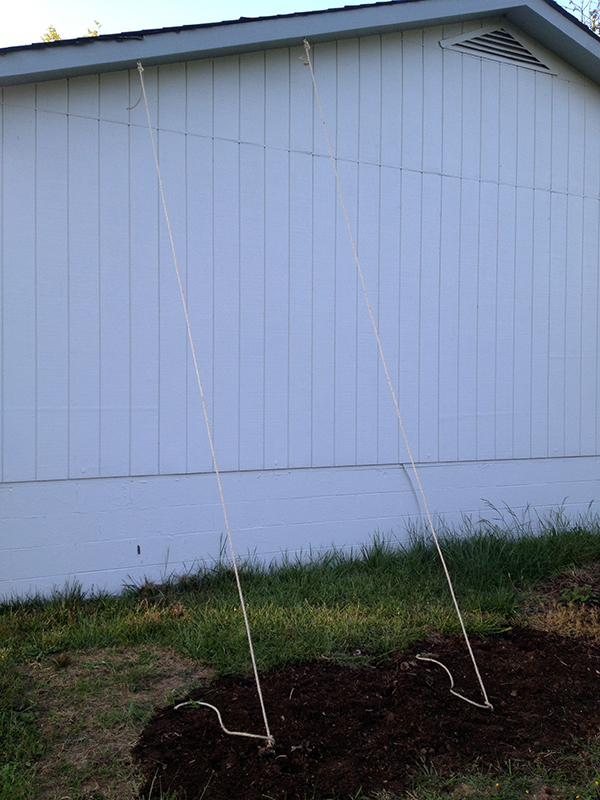
A few weeks passed with no change. Just as I began to worry that I’d gotten some dead rhizomes, tiny leaves appeared. And then there were more. I made chicken wire cages to keep the chickens from eating the hops, and in a few days more sprouts appeared. And then I went away to the beach for eight days, and when I returned my little hop babies had found their ropes and started to twine. So precocious!
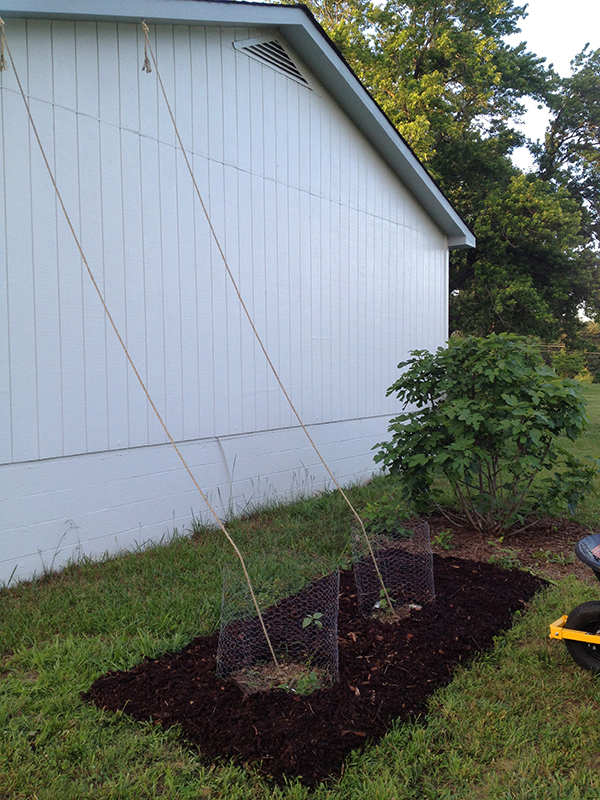
Unfortunately the pasture was fast overtaking this nice, rich new bed, so last weekend I dug out all the weeds, laid down newspaper, and piled mulch on top. This will keep the weed pressure off my hops so they can grow to their max. That’s my Celeste fig next to them, which came through this winter without any intervention from me and is on its way to becoming a beautiful asset.
I found another little snake in the mulch. This is the second “mulch snake” I’ve encountered.
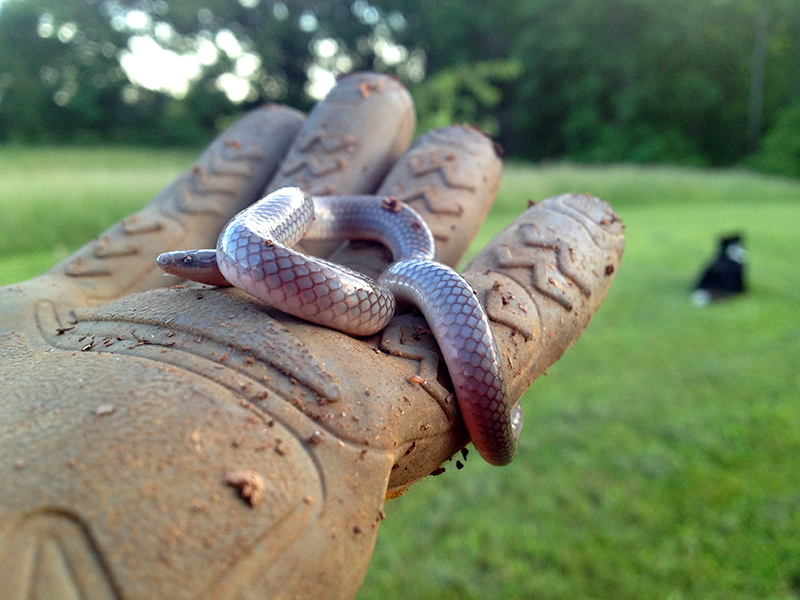
I placed him next to the growing hops. I figured twiney things belonged together.
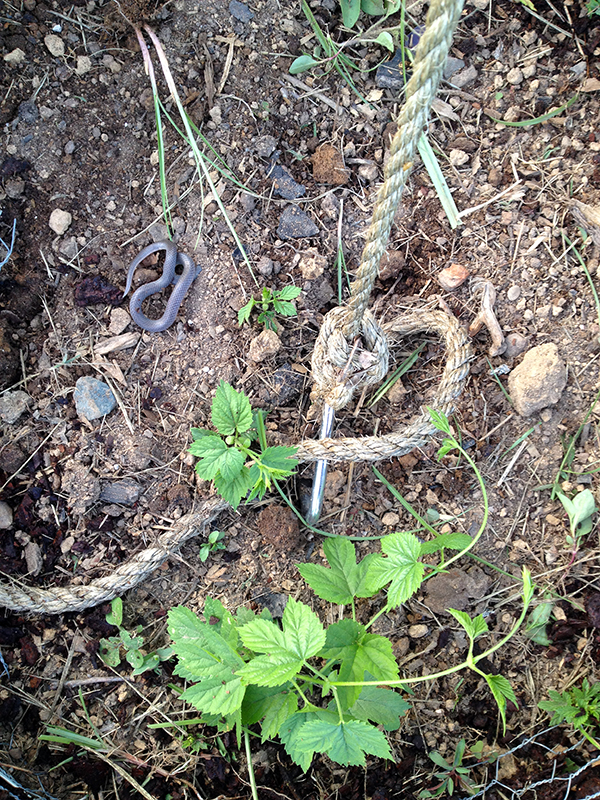
I am very excited to see what my hops do. Maybe someday I’ll be making a Bonafide Brew with my own homegrown hops! And if not, hops are a wonderful herbal sedative often used to induce sleep. A girl can dream…
May 28th, 2013 §
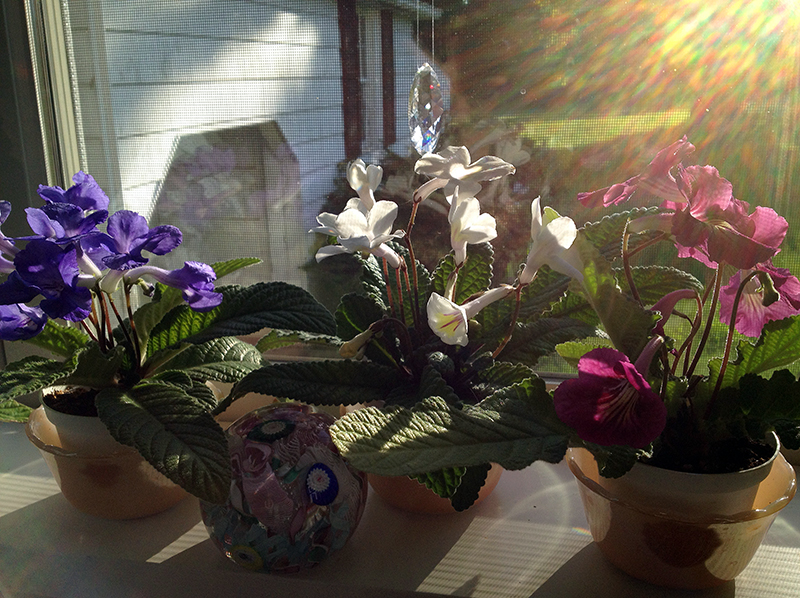
What a busy Memorial Day Weekend!
On Saturday I visited a friend for a look inside his new beehive. We’d taken an into to beekeeping class together this spring, and he won the class drawing for a complete hive with bees. After taking the class I decided against adding bees to the farm this spring, figuring that the roughly $600 outlay to get started with two hives was too much at this time. Further, there are so many things that can go wrong with a bee colony, from diseases to pests to the vagaries of weather and wildlife, that I got nervous I would screw it up and didn’t want to add that stress right now.
However, after seeing Aaron’s beehive, I am totally smitten and kicking myself that, as usual, I over thought it and didn’t jump right in. With complete sincerity I have to say that opening that hive and seeing thousands of beautiful creatures busy creating their perfect home was one of the most miraculous things I have ever seen. The precision of each cell of honeycomb blows my mind, as does the order the bees demonstrate as they go about separating comb into areas to raise brood and store honey.
We added a super (outside box), fed the bees, and inspected each frame of the hive. I learned how to hold a bee-covered frame without dropping it or crushing any bees. We found the queen, distinguished by a red dot of paint on her back, busy in the lowest super. Through this whole experience the bees buzzed about around me and I didn’t feel scared once. I was wearing overalls, my wellies, and a borrowed bee jacket and veil, along with rubber kitchen gloves. I think this delicate armor helped to alleviate any fear of being stung, but I also felt entirely calm around the bees. An inner voice told me that calmer I was, the calmer the bees would be (which is a mindfulness technique I have learned from working with all sorts of animals), and it seemed to work. I just focused on assisting Aaron and my mind was entirely present. It was strangely meditative, actually, moving slowly and deliberately so as not to kill the bees or panic them.
If anything, I’d get a beehive just to feel that peacefulness again. But I have been doing this farm thing long enough to know that the flip side of that wonderful feeling is the sadness that comes when living things in my care get sick, or injured, or fail to thrive.
I spent Sunday working in the garden, planting out a bunch of plants that Aaron sent home with me. I also fabricated more than twenty dahlia supports from 42″ tomato cages. I cut the legs off each cage, bent those wires into u-pins, and brought them to the garden, where I secured them, upside-down for stability, over the more than twenty dahlias that I planted out. I had started these dahlias in pots, some as early as March and others in April, hoping to get earlier blooms than usual. We’ll see if it works. Regardless, I will have very neatly supported plants!
I’ve also been busy tucking zinnia seeds around the house garden, and minding the blossoming veg garden. Lots going on—the growing season is upon us and I can be outside from morning until sunset and not run out of things that need tending.
Then on Memorial Day I went to a cookout hosted by new master gardener friends. When I got home, around 8:30 p.m., I bottled the beer that I made when my friends Brad (my homebrew mentor) and Amy visited in early May.
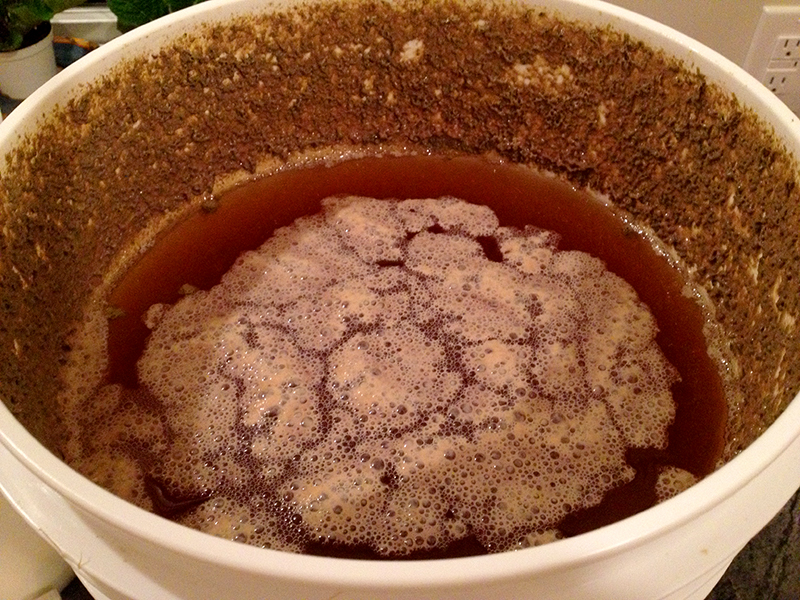
It’s a kölsch, a nice summer sipper, and I am pretty excited about it. I was nervous as the top blew off the fermenter its first day out, but that didn’t seem to negatively affect the beer.
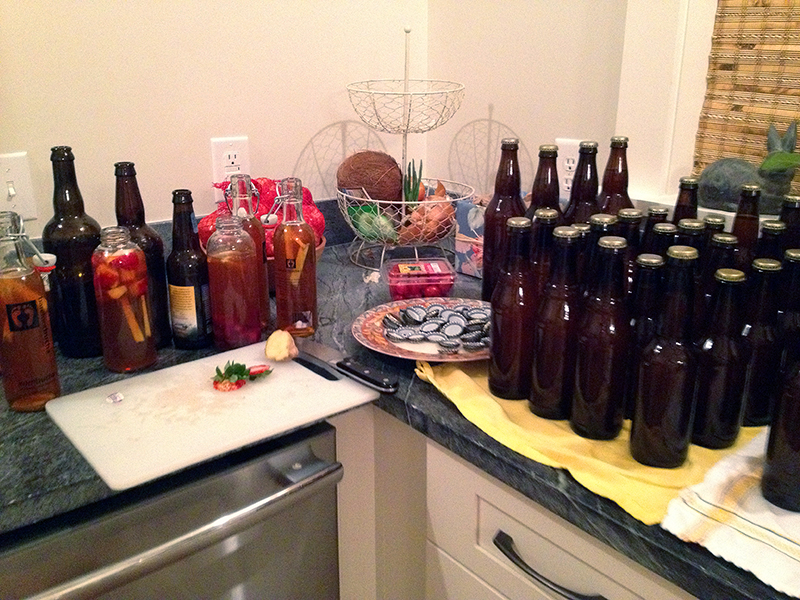
As the kitchen was already a mess, I went ahead and bottled up some of my kombucha. This is the first batch I have made in four years, and it’s delicious. I spiked a few bottles with ginger, cherries and strawberries for a secondary fermentation. And then at nearly midnight I started soaking some wheatgrass seeds, which is a new experiment. I plan to grow them out to add to my green juices.
And so things continue on: growing or not growing, fermenting, decomposing or dying. It’s all happening here, all around me.
May 10th, 2013 §
No matter how I try, within days of clearing off every surface of my house things start to accumulate. And not just any things. Usually they’re living, dirt-covered or maybe even sporting a smidge of chicken poop. Sometimes they’re fermenting, in both good and bad ways.
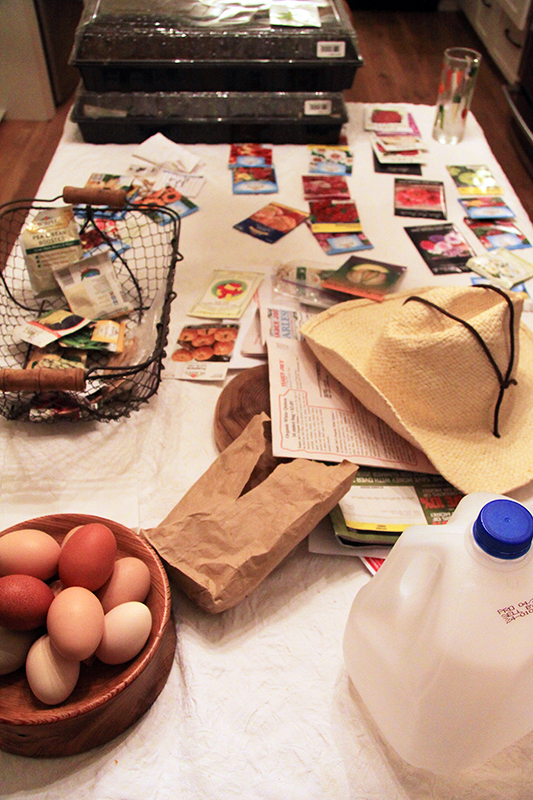
Case in point: my kitchen table right now. I’ve been puzzling out my vegetable/cutting garden plan for days, laying seed packets out like playing cards. A game of solitaire, this is. I’ve also got a few flats of recent experiments: lavender seeds left over from 2011 that I never got around to and the mother of all herbs, Urtica dioica, or stinging nettle. Yes, call me crazy but I am trying to grow that hiker’s bane from seed, hoping to transplant nettle down in the woods by the creek. I was shocked to not find any natively growing here, and as a source of minerals, nutrition and herbal healing it’s too important to live without.
And there’s a jug of spring water left over from Sunday’s homebrew session (which on Monday exploded all over my guest room, as in, I actually had to scrub my ceiling!) And a nice little collection of recent eggs that I am on the fence about refrigerating, thinking I may offer them to a new friend with a broody hen. I’d love it if one of my hens went broody, as I am dying to see what sort of crosses I’d get from my various hens and my Wheaten Ameraucana rooster. I had given myself the parameter that any new chicks would have to be hatched and raised by one of my existing hens, to cut down on labor, mess, and potential flock integration trauma, but with that gorgeous stack of potential just sitting there I am this close to getting an incubator. As if I need another project!
This doesn’t even show the kitchen counter, which is busy nurturing young plant starts and soaking morning glory seeds for planting out tomorrow. And I have a new pet—a kombucha scoby fermenting on the windowsill, waiting to be released into a jug of sweet tea.
As much as not having clear surfaces makes the Virgo in me a bit panicky, I also love living surrounded by my various projects. I recognize that this sort of “mess” is bound to accompany me wherever I go, and it will ebb and flow with the growing seasons and whatever else I am up to. My house smells like moist potting soil and lilac, fermenting beer and wood smoke, mulch-covered dog and iris. It smells alive, and as long as nothing’s putrid I rejoice in this perfume. There’s always January for empty surfaces and clear spaces.


































